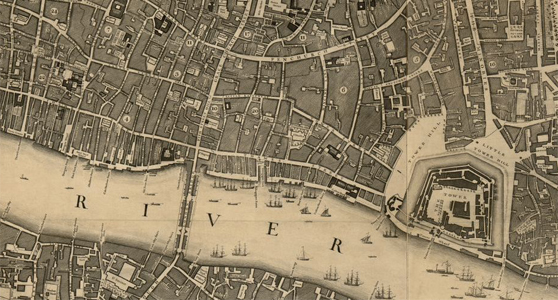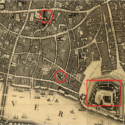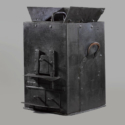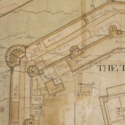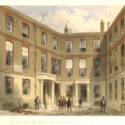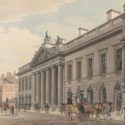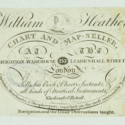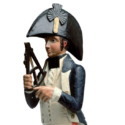Science and the City: Spaces and geographies of Metropolitan Science
Article DOI: https://dx.doi.org/10.15180/211506
Abstract
The Metropolitan Science research project, based at the University of Kent from 2017–2020 and designed to run alongside the Science City gallery project, explores the significant place of craft, trade and commercial institutions in the development of London’s technical and experimental knowledge cultures. Drawing on this research, this paper presents three case studies to show what can be revealed by considering the spaces in and around such institutions – the Royal Mint in the Tower of London, the Trinity House on Water Lane and East India House on Leadenhall Street. These sites combined ceremonial and administrative functions with important roles in the processes of making, codifying, storing, disseminating and assessing knowledge of various kinds. We examine how, both as physical and imaginative spaces, they enabled, structured and limited these processes. Showing the various ways in which the spaces we discuss were defined, policed, used and networked, we consider how their multifunctional character, which often blurred distinctions between public and private, impacted on their communities of knowledge and practice and on broader metropolitan scientific cultures. This is a matter of how they related to other spaces, other authorities, and other resources, but also of how the communities that occupied them sought to balance commercial or craft secrecy with public accountability.
Keywords
commerce, craft, early modern, institutions, knowledge, London, practice, spaces, trade
Introduction
https://dx.doi.org/10.15180/Early modern London was a city of growing population and increasing trade and manufacture, in which public, private, corporate, state and royal interests frequently overlapped. It both required and produced knowledgeable and skilful individuals, as well as the paper and material technologies on which they relied (Bennett and Higgitt, 2019; De Munck and Romano, 2020). The institutional sites of the many corporations involved in London’s governance and productive activity were, among other things, spaces in which such individuals interacted, and repositories for objects, materials and texts. In these multifunctional spaces, knowledge and practice might be used, produced, guarded, tested and represented. As this article shows, the requirements and activities of institutions might shape access to and arrangement of the internal space. The surrounding geography was also important: sites might be deliberately chosen for convenience and proximity to existing locations; the developing requirements of a corporation could change their surroundings; or new types or scales of activity might generate problems in crowded neighbourhoods (Ogborn, 1998).
The sites considered within this article belonged to just three among the many craft, trade and commercial institutions that played a role in the development of technical and experimental knowledge cultures in London. They have been chosen to reveal the broad range of the city’s chartered corporations: a royal institution of national importance, a maritime guild that took on aspects of governance, and a trading company that was based in the metropole but, by the second half of the eighteenth century, controlled a huge overseas territory. However, although their activities, agents and interests extended nationally and internationally, the Royal Mint, Trinity House and the East India Company were all located at the south-eastern corner of the City of London (Figure 1). The first was within the complex of the Tower of London, where city wall met the navigable river. The maritime guild of Trinity House, despite being founded in Deptford Strond in Kent, relocated its headquarters to Water Lane, off Tower Street, running west from Tower Hill. East India House, on the corner of Leadenhall Street and Lime Street, was less than ten minutes north.
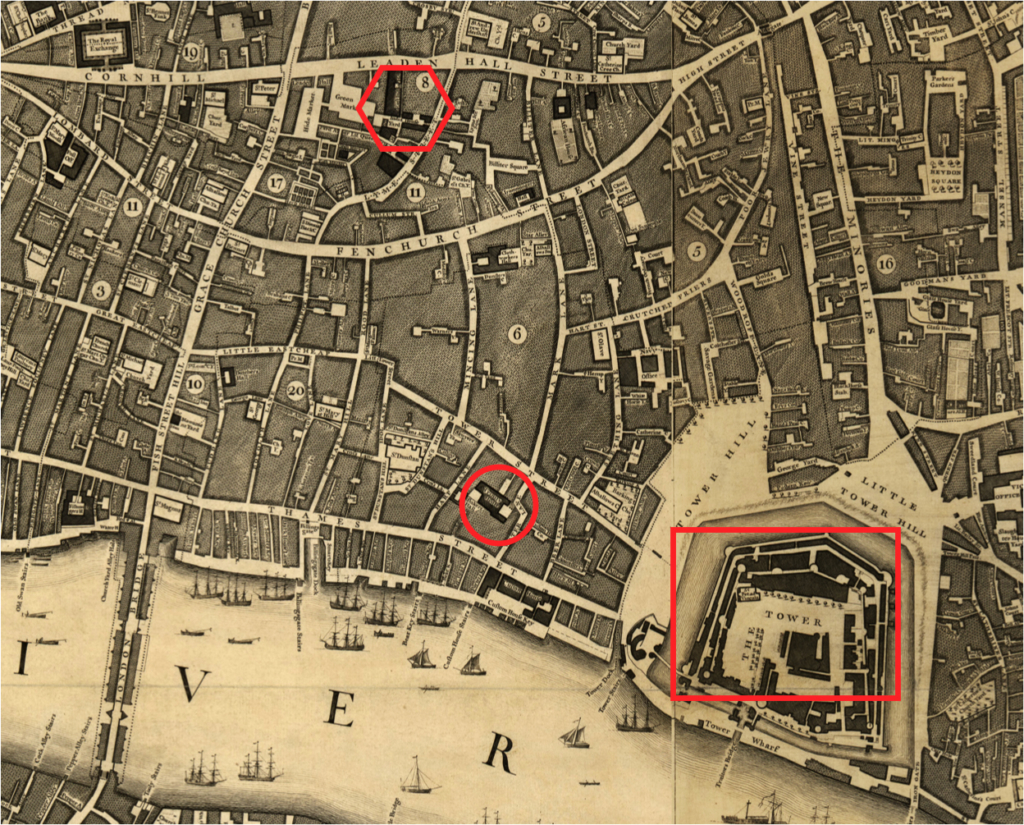
Proximity allowed the sharing of interests and resources, particularly for the overlapping personnel of the East India Company and Trinity House, but also in technical process carried out at the Tower, which drew the attention of curious gentlemen including Samuel Pepys, a Master of Trinity House based at the nearby Navy Office. While the Metropolitan Science research project, of which these case studies form a part, deliberately looks away from institutions most commonly associated with natural knowledge in the early modern period, we note that these alternative sites, and the knowledge and experience they held, were a significant resource for those associated with the new Royal Society of London, including the ever-present Pepys.
The following sections attend to each of these corporations as a case study, showing what spatial approaches can reveal about their knowledge cultures and practices. Considering who entered these sites, how their spaces were controlled or represented corporate authority, and their impact on locality, emphasises how each relied on the knowledge, experience, skills and labour of a range of individuals to achieve their ends. However, the (in)accessibility of these sites, or key spaces within them, reveals concerns about the control of knowledge. Commercial or craft knowledge might be kept secret from competitors or the wider public, but needed to be communicated beyond the site to those who would put it to use. Equally, to ensure the confidence of authorities or investors, it was necessary to demonstrate capability and reliability, often by inviting key individuals into the corporate space. The experience of visitors might be highly mediated, while choices of decoration – symbolising wealth, patronage, charitable giving, or particular kinds of expertise – could create and project a sense of identity or significance. Nevertheless, the multifunctional nature of these sites and the variety of people connected to them meant that they and their meanings were more porous and less stable than those at the top of institutional hierarchies might wish. Indeed, institutional boundaries blur when we consider their wider networks and geographies.
Our case studies show the importance of site regulation, including the statement of rules and placing of gatekeepers, but also the impossibility of full control. For some purposes its appearance could be as effective as its achievement and, at times, openness better served corporate ends. For the Mint, controlling, and being seen to control, their site, and the bodies, materials and tools within it, was essential. Trinity House supported claims to expertise and authority through the contents and use of its eponymous building, while the East India Company was largely content to outsource matters of navigational competence, benefitting from and shaping the private enterprise of teachers, publishers and instrument makers nearby. This exploration of spaces and geographies reveals the flexibility, instability and networked nature of corporate bodies, but also some of the strategies that allowed them to assert collective authority and control over the kinds of knowledge and practice that we have termed ‘metropolitan science’.
The Tower Mint
https://dx.doi.org/10.15180/211506/002We usually think of the Tower of London as a notorious prison, or perhaps a royal storehouse for precious things. But in the early modern mind the Tower evoked a more varied range of associations. In his renowned early seventeenth-century Survey of London, historian John Stow wrote of how:
This tower is a Citadell, to defend or commaund the Citie: a royall place for assemblies, and treaties. A Prison of estate, for the most daungerous offenders: the onely place of coynage for all England at this time: the armorie for warlike prouision: the Treasurie of the ornaments and Jewels of the crowne, and generall conseruer of the most Recordes of the kings Courts of iustice at Westminster (Stow, 1908, Vol 1, p 59).
The impression we get from Stow’s account – written when the White Tower, the largest and most ancient building in the Tower complex was about five hundred years old – is of a highly significant, multifunctional urban site, deeply embedded within collective local and national memory and historical cultures.

Within its walls the early modern Tower of London encompassed, among other institutions, the Mint (where money was made, and precious metals tested and refined), the Ordnance Office (responsible for procurement and storage of munitions and provision of buildings required by the armed forces), and the Royal Menagerie (a space for housing and viewing ‘wild Savage Creatures’) (Parnell, 1993, p 54; Strype, 1720, I.xx.118). These varied Tower institutions employed hundreds of skilled practitioners and technicians, who undertook practices of testing, measurement, and material observation and production which we might categorise as productive ‘scientific’ activities. Many of these Tower employees lived as well as worked on site, blurring boundaries between domestic, institutional and operational spaces. Moreover, the Tower acted as a kind of magnet for expertise, drawing in skilled practitioners – relating to the testing of metals, the manufacturing of coins and weapons, the welfare and reproduction of animals – from across London, Britain, and Europe more broadly.
The Tower was also a tourist destination for affluent and well-connected foreign travellers and dignitaries. By the late sixteenth century, prosperous visitors paid Tower warders for tours, and there were customary routes through the expansive institutional complex, which typically took in the Royal Mint, Armouries, Jewel House, and the exotic animals in the Menagerie. More humble local visitors from the surrounding city came to observe the lions at close quarters, perhaps from as early as the thirteenth century (Deiter, 2008, pp 48, 53−54, 34). After the Restoration, recreational visits to the Tower greatly increased, with fee-paying visitors taking in the Menagerie, Armouries and the dazzling crown jewels (Hahn, 2003, p 122).
Within this busy and crowded site from the thirteenth century was the Royal Mint, the primary institution in England for the production of silver and gold coin. Its officials and moneyers ‘were incorporated as “one body perpetual” with the right to use their own common seal, to hold land, and to sue in any court’ (Challis, 1992, p 184). The Mint has typically been framed in terms of its institutional politics, flows of bullion, and specific levels of coin production, but it was also a significant urban space of technical knowledge and industrious labour and, at certain moments, experimental practice. It was a royal institution within which labourers, artisans, technical experts, institutional officials and gentlemen interacted. These varied social orders had a shared interest in metallurgy, and the production and testing of coin more specifically. Here we consider the Mint as a space of skilled knowledge exchange.
The built environment of the Mint consisted of a series of structures which gradually spread, by the end of the fifteenth century, to fill the narrow space between the inner and outer walls of the Tower. The most significant Mint buildings were situated along Mint Street, which ran from Byward Tower to Legge’s Mount. In addition to workshops were stores, stables, coach houses, domestic residences, and even gardens (Challis, 1978, pp 1−3; Craig, 1946, p 1). It is very likely that the varied workshop processes at the Mint, for example those of assaying, melting and weighing, were undertaken in different ‘houses’ (or certainly, at least, separate chambers). The pronounced separation of the different workshop practices of coin production and testing was no doubt partly a practical measure, but the spatial organisation of the Royal Mint perhaps also held a deeper symbolic significance. As with Italian Mint architecture, ‘the presence of distinct spaces within the Mint for different types of activity reassured coin users that the materiality of coins had not been compromised, and thus inculcated confidence in the monetary system’ (Jacobi, 2019, p 74).
Those employed at the Tower Mint engaged in a range of different activities and were expert in a variety of technical knowledges. Workers included weighers (who calculated the weight of metals brought into the Mint), melters (who liquefied the bullion), refiners, engravers, assayers and moneyers (‘who are, some to sheer the Money, some to forge it; some to beat it broad, some to round it, and some to stamp or coin it’) (Strype, 1720, I.xviii.96). Frustratingly, there are very few archival traces for the moneyers of the Tower, who fashioned the blanks and struck the coins. It is likely that they formed a craft fellowship or guild from around the mid-fifteenth century, providing training for apprentices and mutual support (Freeman, 2000; Challis, 1975). Moneyers’ Hall was situated within the Tower site for their collective socialising and administration (visible in Figure 4 below) (Challis, 1992, p 363). Pointedly, in the archival records of the Mint, seventeenth-century workers in coin specifically referred to their labour as ‘industry’ or ‘industrious’.[1] By this they were emphasising the ingenious and skilful elements of their practice.[2]
At the Assay House, probably located at the north-west corner of the Tower, were men responsible for testing the precious metal content of ores, bullion, coinage, and plate; assayers were a highly significant group of skilled artisans at the Tower site. Assay by fire involved an experiential understanding of many workshop variables, including furnace temperatures, and the malleability of metals. All metals brought into the Mint were assayed before being melted down for coin production, and after minting, batches of coins were assayed to ensure they were of the correct weight and fineness. At the annual Trial of the Pyx the integrity of the institution and the expertise of the master assayer were put to the test (Kilburn-Toppin, 2019, pp 5, 15, 20). This highly ceremonial testing process at the court of Star Chamber at Westminster involved the assay of a sample of coins produced at the Mint by a jury of experienced goldsmiths, to ensure the coinage met the standards set by the Crown.[3] Engaged in the separation and transformation of matter, assayers and the affairs of their workshops were a curiosity for those interested in the secrets of nature, material trials, or experiments. The Assay House at the Royal Mint was a specific site of curiosity. Merchant and economic writer Gerard Malynes reported in 1622 that ‘coming to the Assay-house [within the Tower liberties], there we found diuers gentlemen desirous to see the manner of making of Assayes of Gold and Siluer’ (Malynes, 1622, Vol 1, p 284).

The Royal Mint was a productive and experimental urban space that had a complicated relationship with secrecy. The drive for secrecy operated at a number of institutional, social, political and cultural levels. The operations of the Mint were meant to be secret, a form of ‘intentionally concealed’ technical knowledge, understood and observed by only a select group of royal officials and employees (Long, 2001, p 7). This was an era in which ‘coinage was regarded as a crucial state secret, and the ability to handle and keep secrets was therefore indispensable’ (Jütte, 2015, p 104). This secret approach was closely linked to fears of counterfeit currency. Further, the arts of metalworkers were craft mysteries, which were not to be observed or repeated by the uninitiated. This was part of a broader late-medieval and early modern urban culture of ‘proprietary attitudes towards craft knowledge’ (Long, 2001, p 1). And yet, we find that the everyday reality could be quite different. The site had seemingly porous boundaries; movement through the Mint was hard to control, and those with the right social connections might gain legitimate access to view operational practices and personnel. A handful of its workers also authored seemingly revelatory ‘books of secrets’.
Sensitivities on the part of English royal and institutional elites concerning the discussion of bullion, coin, and procedures for their regulation were especially heightened at certain moments, for example, following the mid sixteenth-century monetary debasements or when new production techniques were introduced, as in the 1660s recoinage. This led to spaces associated with coinage and the machinery they contained becoming increasingly regulated. When the Parisian engineer Pierre Blondeau was employed at the Mint for the purpose of mechanising the coinage of the newly crowned Charles II he was sworn only ‘to discover his Secrets in rounding the pieces before they are sized, and in making the edges of the moneys with letters and grayvings’ to officers of the Mint and ‘unto his Majesty if he shall please to do him the Honour of being a witness unto his Art and Inventions’.[4] Blondeau had previously visited the Interregnum Mint from 1649 with an ‘innovative device’ of ‘an edge-marking process’ for newly minted coins, but he was not formally employed by the Commonwealth (Challis, 1992, pp 329−30).
Blondeau had his own ideas about the imperative of secrecy, closely linked to the desire to protect his invention of an edge-marking process. He expressed these preferences for concealed technology in print in the early 1650s in a series of bitter exchanges with the corporation of moneyers at the Mint. The French engineer wrote of how ‘the Invention needs not be made publick; But if it be the pleasure of the State, the Engines wherewith the brims are marked, may be kept secret among few men, who shall be sworn to keep it, and not to reveal it to anie’. Blondeau stressed that since his arrival in England two years previously (September 1649), ‘the Officers and Workmen of the Mint have made their utmost endeavours to finde out my Invention, which they could not attain unto, although the Master of the Mint hath had in his hands 10 my Patterns above nine moneths together’. Besides, he claimed the moneyers at the Mint had entreated the royal committee ‘that I should bee commanded to make a new tryal here, hoping they should be able to discover my secret […] but they could not’. Indeed, when it came to a competitive trial between Pierre Blondeau and David Ramage (on behalf of the moneyers), the former produced a much higher quantity and quality of coin, though ‘while the Commonwealth lasted, he remained without formal employment at the Mint’ (Challis, 1992, p 330).
The institutional ideal of secrecy surrounding the production of coinage and testing of metals was reflected and reinforced through security measures at the Tower site. A porter was employed at the Mint, specifically to regulate the movement of people and goods in and out of the office of receipt, the chamber to which customers (typically merchants and goldsmiths) brought their bullion (Challis, 1992, pp 268, 286). The degree to which this official was also required to regulate the movement and potential indiscretions of institutional employees is reflected in a statement by the officers of the Mint in December 1664:
that in Order to the preserving of the Reputation of his Majestys said Mint and the better securing the money and bullion of Gold and Silver from time to time delivered into his Majesty’s Office of Receipt in the Mint, there ever was, and still is a Porter appointed to take accompt of all persons repairing thither and (with the Assistance of some of the Monyers) to search dayly in his lodge (in times of coyning) workmen at their going out and all suspicious persons as also to stop all such moneyers or workmen as should depart to leave their work before the hours appointed or allowed them.[5]
However, effectively managing the movement of people and objects through the Tower complex proved to be an immense challenge in the early modern period, in large measure because of the multifunctionality of the site, and the social diversity of its working population. Correspondingly, particular groups and institutional workers were keen to assert their free movement through the building complex and associated privileged statuses. And thus, in December 1664, officers of the Mint were eager to remind royal governors that they had always:
had a particular and distinct Jurisdiction and Authority within themselves independent of the Constable or Lieutenant of the Tower and of the Master and Officers of the Ordnance with free Ingress, Egress, and Regress at all times for themselves and Servants […] without any disturbance, letting or gainsaying.[6]
Moreover, despite the existence of the porter at the Mint, the illicit movement of people and material things (specifically tools) was clearly taking place; the regularity with which prohibitions of movement were repeated in the Mint records is itself highly suggestive of the continuation of forbidden practices. We see this concern of illicit traffic manifest with particular intensity during the 1660s, coinciding with the mechanisation of the new coinage. The central anxiety on the part of Mint officials was evidently counterfeiting. In January 1661/62 in relation to the ‘fabrick of money by way of press or screw [the mechanisation of the coinage] and the preventing of Abuses therein’ it was decreed ‘that no Graver or Gravers whatsoever shall henceforth grave or work any original master puncheons, matrices, stamps and dyes, or any irons for coyning either by way of the press or hammer in any place but in his majestys mint in the Tower of London’. More explicitly, it was stressed that ‘for the better preventing the Counterfeiting of the new current moneys of this Kingdom’, moneyers were not permitted to ‘keep or use any of the Presses, Cutters, or any other Tools or Engines employed in the new way of Coyning or in the making of the moneys with cutters or grayvings about the edges’. If ‘such presses, rowlers and other tools and engines’ were found outside the site of the Mint, they were to be seized, secured and destroyed by its officers.[7] Regular inventories were also made of coining workshops, in an attempt to keep track of their material contents.
Aside from the distinct possibility of tools being smuggled out of the Mint workshops, there was also the issue of managing the broader population of the Mint site. We noted earlier how the Mint had spread by this date to encompass the entire outer horseshoe complex between the walls of the Tower. In the early 1660s the officers of the Mint gave ‘a particular accompt of all persons who have Intruded and now Inhabit within the Mint or precincts thereof and have no relation thereunto’.[8] These were clearly individuals and families that had no particular employment at the Mint. Several years later, in 1664, there were further complaints of ‘many incroachments made upon the Jurisdictions and Libertys of his Majesty’s said mint’, which were said to diminish the reputation of the institution and to act as a ‘great danger and prejudice of his Majesty’s Officers and moneyers there by the keeping of common drinking houses and building of workhouses, sheds, and forges for wheelrights, carpenters and smiths etc.’.[9] There was evidently a double concern at play here. First, the unease that these spaces, their activities and persons were largely unregulated; second, that these structures were taking up space which was now urgently needed for Mint activities and personnel to accommodate new coining equipment. It was ordered by the royal council that ‘all persons using or inhabiting any lodgings or houses situate or being between the two Mint Gates of the Mint’ should ‘remove themselves and their families’.[10] This was said to be ‘for the better security of our said Mint, and for the accommodating of such other officers and workemen as hereafter shalbe employed in the making of Tooles and Engine, and in Coyning our Moneys by the Mill and Presse’.[11]
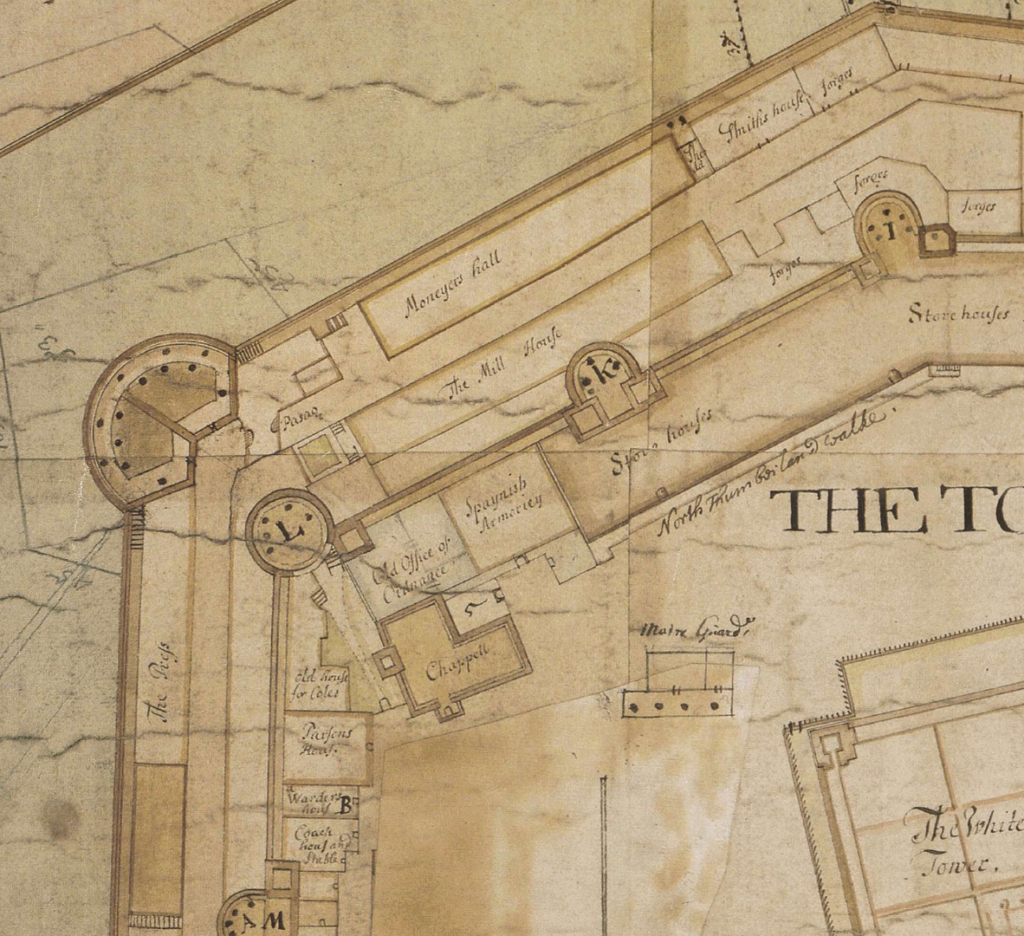
The distinct concern that the Mint site was overcrowded and thus unregulated and insecure continued into the next decade. In 1679 Sir Henry Slingsby, Master of the Mint warned of the:
dangers and hazards which may happen by reason of the great concourse of people […] inhabiting within the said Mint (though not belonging to it) especially to the smith of the Ordnance who making all sorts of Iron work there do dayly cause the crowding up of ye Mint w[i]th land and sea carriages, and the drawing number of carpenters, painters, and other workmen thither.[12]
Here we see how the multifunctionality of the Tower site impacted upon the industrious and tightly regulated activities of the Mint. As a result of Slingsby’s complaint the royal council ‘viewed the several parts of the mint’, ‘examined the Rights and Boundarys therof’, and found that the smith employed by the Ordnance Office was indeed ‘dwelling and working in ye mint and making and fitting double headed shott, and all sorts of Iron work for that service’. This industry had resulted in:
a great and dayly concourse of people thither the crowding it up with land and sea carriages and the drawing a great number of Carpenters, Wheelrights, Painters and other workmen to your Majesty’s mint which is thereby rendered as publick as the common streets and lyable to many dangers losses and Inconveniencys.[13]
The allegedly ‘public’ nature of the Mint site in the 1670s was in clear contrast to the institutional ideal of a closely managed, concealed space.
There was additionally a social dynamic at work which complicated the principle of secrecy associated with the Royal Mint, and this relates to curious visitors. The activities of refining and testing metals, and the newly mechanised coining process were of considerable interest to those we might broadly define as gentlemen natural philosophers. There is evidence to suggest that men with the right social and institutional connections might gain access to Mint workshops associated with monetary production and metallurgical testing. On Tuesday 19 May 1663, Samuel Pepys (soon to become a fellow and, later, president of the Royal Society), thoroughly enjoyed a social and investigative visit to the Tower Mint, together with a naval associate. A personal friend of Sir Henry Slingsby, Pepys recorded in his diary how he was:
shown the method of making this new money, from the beginning to the end, which is so pretty that I did take a note of every part of it and set them down by themselves for my remembrance hereafter. […] and after dinner went to the Assay Office and there saw the manner of assaying of gold and silver, and how silver melted down with gold do part, just being put into aqua-fortis, the silver turning into water, and the gold lying whole in the very form it was put in, mixed of gold and silver, which is a miracle… (Pepys, 2013, 1663/05/19).
Tellingly, Pepys described the process as both an ‘experiment’ and a ‘mystery’. The Tower Mint was a significant space for material production, transformation and investigation in the early modern metropolis. Understanding its complex knowledge culture requires paying close attention to the physical built environment, and the movement of people and things (including tools and coins) through the space. The socially complex, physically expansive and multifunctional nature of the Tower site impacted upon its institutional culture of secrecy. Built environment and knowledge culture were here mutually constitutive.
Trinity House
https://dx.doi.org/10.15180/211506/003If the Mint was explicitly made up of both royally appointed officials and craftsmen, Trinity House was a ‘Guild Fraternity or Brotherhood’ of ships’ masters, captains and pilots that came to include representatives of the Admiralty and Navy Board, of overseas trading companies and of social and political elites (Adams and Woodman, 2013). Incorporated in 1514, it was founded in and remained connected to the maritime community of Deptford Strond. After the Restoration, however, it moved to the City of London. Between 1661 and 1798, the Trinity House was located on Water Lane in Tower Street Ward. This location was well placed for its proximity to other spaces relevant to its business and its governing members, the Elder Brethren. East of London Bridge, it was at the top of the navigable River Thames, which Trinity House surveyed, marked, dredged and helped to police. They were experts in navigating its channels and the coasts beyond, and examined others in this knowledge and skill. On the river, at the south end of Water Lane, was Custom House, where ships’ masters were obliged to declare imports and paid a range of taxes and dues, including to Trinity House. To the east was Tower Wharf, where ordnance was loaded and, in some periods, certified by Trinity House. Walking north, the Elder Brethren could reach the Navy Office in Seething Lane – in which some worked and for which they provided pilots and certified masters – and Muscovy House or East India House, the overseas trade of which had supported the Merchant Brothers’ careers as commanders, ship owners, investors or directors.
Rented from 1661, then purchased after fire led to its rebuilding in 1715–18, the courtyard house in Water Lane consisted of three storeys over vaults and cellars, which were rented out for income, and small courtyards to the front and rear. Although drawn after the Corporation had moved to a new building on Tower Hill, Shepherd’s watercolour shows the building largely as it was when they occupied it from 1718 to 1798 (Figure 5). The building does not survive, and there are no representations of its interior, but drawing on Trinity House’s archive and printed and manuscript accounts allows us to partially reconstruct the building, revealing the objects, records and people it housed or hosted, and some of the ways in which the expertise claimed by the Brethren was constructed, represented and put to use within it.
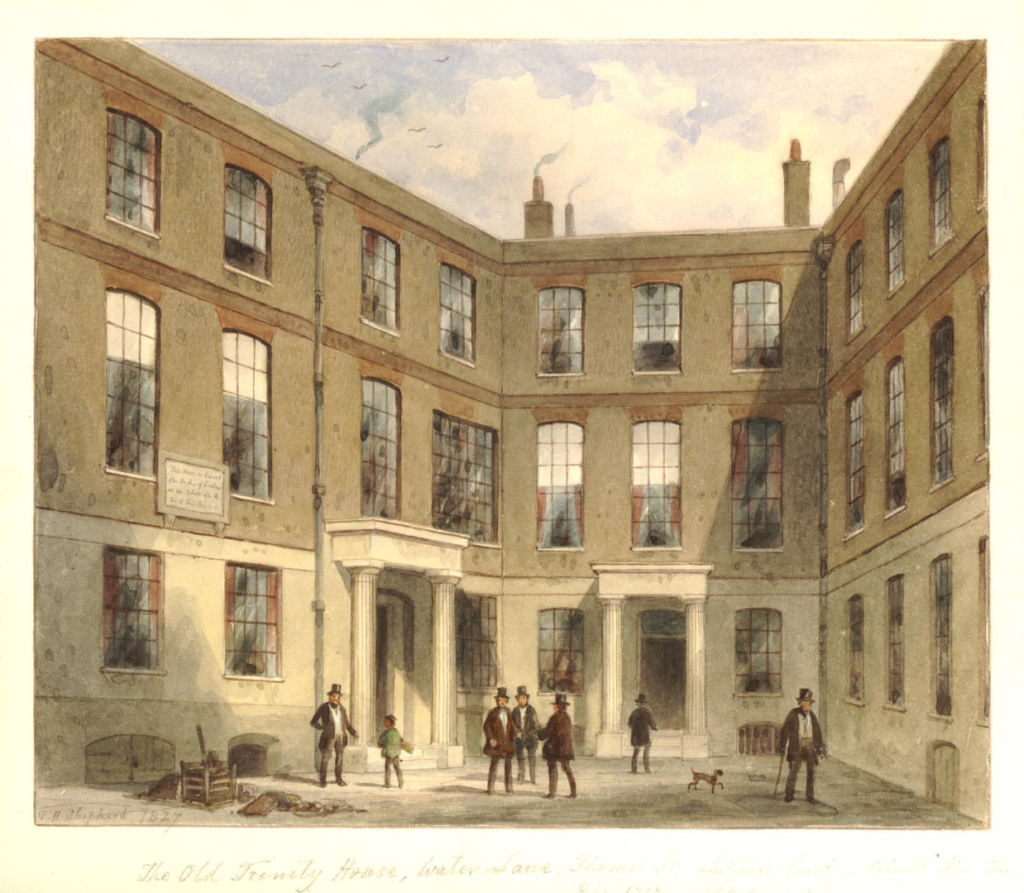
While Samuel Pepys, who became a Younger and then Elder Brother and was twice Master, left comments on the conversation and quality of food when dining at Trinity House, his diary contains no description of the building. However, Strype’s Survey does note some of the contents of the main two rooms, a Hall – where meetings of the General Court were held – and a parlour – where the smaller By-Boards met and examinations were carried out. Typically for guilds or professional bodies, the Corporation displayed portraits, plaques and objects that recorded the generosity and sense of belonging among the Brothers, celebrated external patronage, projected a significant institutional history and symbolised the knowledge, practices and milieu of their calling (Kilburn-Toppin, 2017; Jordanova, 2018).
Around the Hall were ‘divers Tables fairly writ, some in Gold, of the Names of their Benefactors, with their Gifts; whereof some was Land, some Sums of Money, and some Plate’, going back to 1612 (Strype, 1720, II.xviii.289). Some gifts were physically present, symbolic of relevant skill and knowledge, such as those from two admirals and former Masters of Trinity House: ‘the exact Model of a Ship of a great size rigged, enclosed in a Frame glazed round; the Gift of Sir Jeremy Smith: Likewise two large Globes enclosed…; the Gift of Sir Thomas Allen [Allin]’. Maritime adventure was represented with ‘an old Flag hanging up, which they say was taken from the Spaniards by Sir Francis Drake, whose Picture hangeth up there’ and, in the parlour, ‘five large Plats drawn curiously and exactly by a Pen, describing certain Sea Fights in King Charles II’s Time’ (Strype, 1720, I.iii.42). Drake was represented as an expert navigator, one hand resting on a globe showing the ecliptic, symbolic of astronomical and cartographic knowledge. There were also portraits of some Elder Brethren, the several monarchs who had granted them charters and other patrons.[14] Together, these objects marked Trinity House as a space of collective maritime experience and authority.
In such surroundings, maritime knowledge and practice was shared, certified and acted on. Much of this knowledge – of ships, their crews, maritime law and habits as well as navigation – was understood to reside in the persons of the experienced mariners among their number, and which was shared through conversation and ship-board practice and training. Such could be tested verbally in examinations of pilots and ships’ masters, which focused largely on the details of specific channels, marks and sailing directions (Schotte, 2019, pp 93−99).[15] It was also stored by the Corporation in the form of reports and surveys carried out by selected Elder Brothers, whether in response to reported change, at the request of the Navy Office, or to maintain and demonstrate their own collective mastery of the challenging environment of the Thames and its estuary.[16]
Trinity House also maintained a library, the first indication of which is among the bequests recorded in the Hall. Thomas Allin not only gave the globes but also £100, ‘to be laid out in Books for the Use of the Corporation, according to a Catalogue by him to be brought in’ (Strype, 1720, II.xviii.290). Fifty years later, the collection was sufficient for an inventory to be taken.[17] The books seem to have survived the fire of January 1715, which destroyed much of the building but otherwise only ‘some of the old Tables and chairs’.[18] Richard Noyes, the clerk, was commended, and his widow ultimately recompensed, for his selfless act of saving ‘the Corporation’s Books’, i.e. their archive, and ‘their Cash and Goods’ at the expense of his own belongings (Whormby, 1746, p xvii).[19] Although there seems to have been little proactive acquisition, the library grew with the addition of gifts and subscriptions.[20] There is occasional record of books being borrowed or consulted and the very presence of a library was a symbol of the collective knowledge and interests of the Elder Brethren.
A wide range of people might have reason to enter Trinity House. Pepys’s diary records dinners with the Elder Brethren – captains and ‘old men’, Admiralty and Navy officials – and guests such as Ordnance officers from the neighbouring Tower of London (Pepys, 2013, 1664/3/23 and 1662/11/4). Court meetings might invite the masters and pilots who wished to be sworn in as Younger Brethren or to be examined and certified as qualified to take charge of ships over particular routes or of different rates of Royal Navy ships. There were also those who were to be quizzed or reprimanded in relation to accidents or disciplinary incidents, including ballast and lightermen who did the work of dredging the Thames and loading the dredged sand and waste as ballast, a business overseen by Elder Brothers assigned to the Ballast Office and their clerks. Further visitors included those who worked for Trinity House as keepers of buoys and lighthouses, collectors of dues or agents further round the coast, and those hoping to receive such appointments. Others looking for advantage and approval included projectors with new machines, instruments or proposed schemes. Drawing authority from their practical experience at sea, and the collective power of corporate history and presence, the Elder Brethren would test their plausibility and credentials, as well as the potential usefulness or desirability of their ideas.
That activity gained significance by being undertaken within the corporate site is clear when we consider Trinity House’s mathematical examinations. These began with the foundation of the Mathematical School at Christ’s Hospital in 1673, where selected boys were taught mathematics, astronomy and navigation in preparation for examination at and apprenticeship by Trinity House (Jones, 2015). Initially they were examined by the Elder Brethren, but the text-based theoretical techniques that the scholars were taught proved to be beyond their own training and regular practice. From the end of 1682, therefore, they paid a mathematical teacher to carry out the examinations on their behalf.[21] These were, nevertheless, always carried out at Water Lane and those who passed were certified by the authority of the Corporation. A succession of mathematical examiners allowed Trinity House to carry out their obligation to the monarch – who paid for the scholars’ maintenance – and to the Admiralty, which from 1702 also required them to examine those who wished to be appointed as schoolmasters on the King’s ships. It was a tacit admission that the Elder Brethren lacked knowledge of mathematical theory of navigation but it was a gap that was, corporately, filled effectively.
For those with legitimate business, judged no doubt on appearance as well as credentials or verbal account, Trinity House was open and accessible. The many charitable beneficiaries of the Corporation tended to be kept away, instead interacting with officers at the almshouses in Deptford and Mile End, or with the Elder Brethren responsible for different areas of the maritime communities east of London. The building in busy Water Lane had several barriers to negotiate, not least the large wooden gates that separated street from courtyard (see Figure 6). At some periods they appointed a beadle ‘to prevent the disorderly Crowds of People resorting to this House’, though whether these were passers-by, discontented pilots refusing to pay poundage, or ballastmen demanding higher rates of pay is not made clear. The beadle was a pensioner of the Corporation, a former pilot, master or ballastman, who received an additional 20 shillings per month and had his status made plain by being supplied with a gown, staff and hat.[22] Beyond the beadle, visitors also negotiated the clerks and two ‘Door Keepers of the Council Chamber’, whose presence underlined the exclusive nature of corporate governance and authority (Griffiths, 1997, p 928).[23]
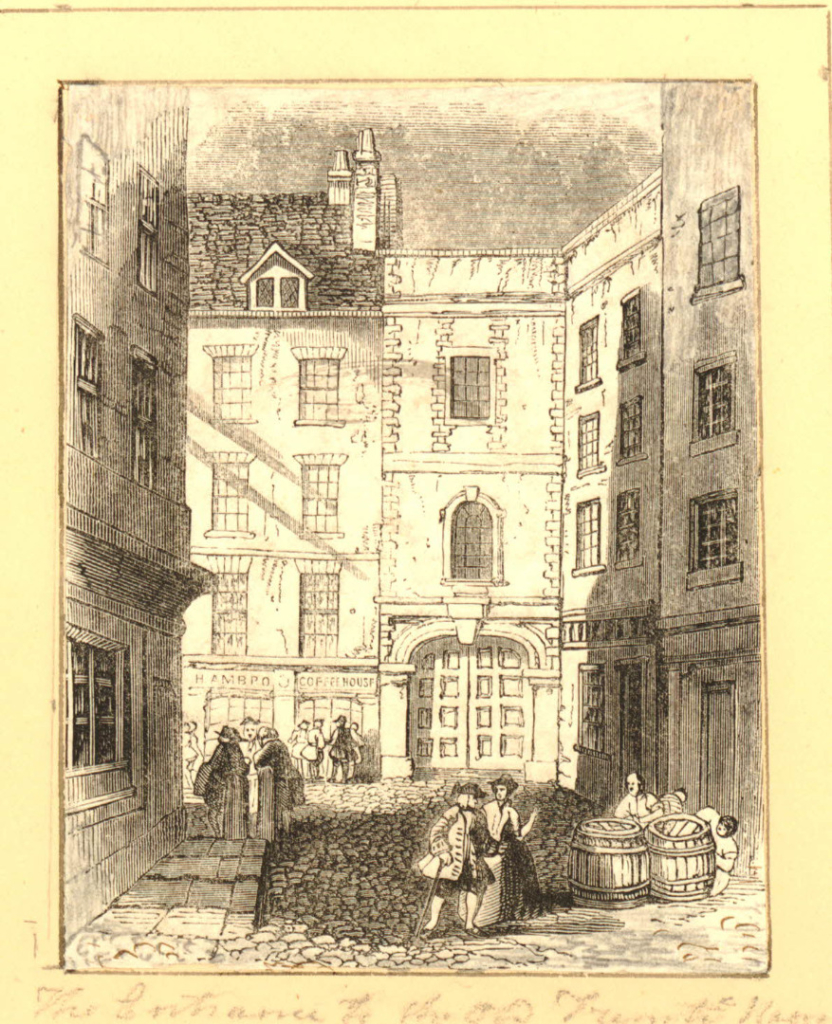
The story of one man with legitimate business at Trinity House provides a rare account of his dealings there, revealing the importance of the building and these guardians of the site. He was Nathan Prince, a former scholar and tutor in mathematics at Harvard University who, accused of intemperance, had lost his position and, after a failed attempt to establish a mathematical school in Boston, had accepted a position as a missionary in the Caribbean (Sachse, 1956, p 94; Morris, 2011). He had travelled to London in 1747 to be ordained and, having been forced to work his passage over the Atlantic as a schoolmaster on board the Vigilant, also required certification from the Admiralty, after passing examination at Trinity House. The Corporation had been alerted to the need for an examination and, just a day after his arrival in London, ‘the Doorkeeper of Trinity House’ called at his lodgings ‘and said he would forward my affair’ (Sachse, 1956, pp 82, 87).
He was told to visit William Mountaine, the Corporation’s mathematical examiner, in preparation for attendance at Trinity House the following day, when there would be a meeting of Court. Having set out to London ‘in mean clothes’, Prince was now prompted to get ‘my hat and brown coat and black breeches’ – presumably his missionary garb. Mountaine received Prince at his home in Shad Thames to discuss the requisite knowledge, and clearly trusted him as a fellow mathematician sufficiently to lend him the key textbooks.[24] The diary records what was covered in the examination, and that they skipped the theory of the globe, since Prince had ‘taught it to scores in New England’. Mountaine, who prompted or explained different approaches to problems where Prince had supplied an unexpected answer, saw the result as a foregone conclusion: he completed his testimonial for the Elder Brothers before the examination was finished (Sachse, 1956, pp 87, 89–90, 92–93).
However, the examination, conducted on two separate days, was by necessity carried out at Water Lane. It also had to coincide with Court meetings so that the Elder Brothers and Deputy Master would be present to produce a certificate, relating the successful examination to the Admiralty. On arrival, Prince had to show his testimonials from the Vigilant to the clerk, which attested to his ‘sober life and conversation and good affection to his Majesty’s person and government’. The following week, Prince again went to Mountaine’s home before the two proceeded back across the river to Water Lane to resume the examination. Mountaine declined the offer of a fee for the examination but told Prince, ‘you must pay the Secretary 15s. for your certificate. And you may give 6d. or a shilling to the Doorkeeper for his service, for I’ll assure you he promoted your affair’. Prince ultimately pleased both by giving the clerk a guinea, lacking smaller change, and half a crown to the doorkeeper, who passed on 6d to the lower doorkeeper (Sachse, 1956, pp 93−94).
Prince had found himself waiting at Trinity House, for secretaries or for examiner, long enough to have taken some notice of his surroundings. He saw the portrait of Drake in ‘the Common Hall’, with a face he considered ‘not grand or heroic, but full of a pert, sharp life’, and the record of gifts from Sir Charles Wager, Master of Trinity House and First Lord of the Admiralty, and James Prince, presumably a relation and possibly the chaplain to Trinity House’s Mile End almshouses of the same name (Patterson, 1714, p 277). In the room in which he was examined, he noted the portraits of ‘Charles II and of James II when Duke of York, and other great men’, and Mountaine told him of the original portrait of Elizabeth in the Court room (Sachse, 1956, pp 93−94).
Careful gatekeeping and a sense of grandeur were undoubtedly intended to impress on examination candidates the gravity of the occasion, and create the appearance of an authoritative process. However, some of the knowledge for which the Elder Brethren were responsible had to be distributed widely, for the safety of mariners and shipping and to ensure that the Corporation was seen as attending to its responsibilities – a quid pro quo for their various privileges. Some of this was available within the most frequented part of the house at Water Lane, the Ballast Office, where the identity and measurement of each ballast lighter, and the penalties for not taking ballast from Trinity House, were displayed on the wall (Strype, 1720, II.xviii.289). That the tonnage of the lighters, and the scales they displayed showing the weight of the ballast they took on or unloaded, had been accurately weighed and marked was a matter of trust. It was, therefore, done publicly, with the ‘time and place of weighing’ advertised at Billingsgate, so ‘That Masters of Ships may (if they think fitt) attend and see the same justly gauged and marked’.[25]
Information about new, missing or replaced marks, lights and buoys in the Thames channels and coasts was also posted at busy wharfs and circulated in print, via the daily press or their agents. When, for example, Trinity House was informed that a sea mark on Ashy Down on the Isle of Wight had been blown down during a recent storm, it was ordered that an advertisement be put in The London Gazette to alert mariners to the missing mark and ‘Notifying, The same will be rebuilt as soon as possible’.[26] New sailing directions, required by such changes or shifts of sand banks and coastlines, were also published.[27] While this knowledge had once been seen by pilots as a secret of their trade, in the eighteenth century it was advertised by the Corporation for ‘public benefit’, attention to which now supported Trinity House’s claims to expertise and the monopolies, privileges and status they had gained.
Thus, while access to Trinity House was carefully managed, it was essential that information was shared, and that the wide range of people who gave the Corporation geographical reach and key skills could gain admittance. The corporate power of the site is evident from the fact that, although carried out by an external expert, mathematical examinations had to be undertaken there to be legitimate. Examination candidates, like those who sought a hearing at Courts, had to navigate a series of physical and official barriers before finding themselves in surroundings that signalled that this ordinary courtyard house was a representation of maritime knowledge and authority.
East India House
https://dx.doi.org/10.15180/211506/004East India House – a term of convenience for the succession of London premises occupied by the English East India Company from its incorporation in December 1600 until it was formally wound up in 1858 – was a space, or rather a set of spaces, in which knowledge, monopoly and authority were similarly entangled. Initially in the Fenchurch Street house of its first governor, Sir Thomas Smythe, then in a rented house in Bishopsgate, and from 1638 in Leadenhall Street, the Company’s London headquarters was where its governing body met, where its commercial and administrative decisions were taken, and its records kept. It was also, in the last third of the eighteenth century, the centre of ultimate political authority over a vast South Asian territory, and it housed large collections of books, manuscripts, and natural and artificial specimens from those lands. By the end of the eighteenth century, East India House developed into a major centre of navigational, cartographic, natural-historical and cultural knowledge of Asia, with those collections increasingly being put to use or on display.
This process of centralisation was, however, long and complex. For much of the Company’s busiest period, in terms of the volume of shipping, East India House was rather the centre of gravity than a centre of control for a wider network of practices, trades and crafts that serviced its long-distance trade. This case study is concerned with how this came about, and the ways in which East India House – a space that, like the Mint and Trinity House, was quasi-public in certain respects, and which exercised a public function, but to which access was closely controlled in many others – came to function as the centre of a cluster of businesses that served the needs of its officers in ways that were shaped by the Company’s specific directives and technical requirements. This situation can be contextualised by looking back into the Company’s history, showing that its tendency to leave the systematisation, codification and certification of navigational knowledge and proficiency in the hands of private enterprise was broadly consistent with some very early-established practices.
At its foundation the East India Company faced a specific navigational challenge – how to mobilise, sustain and transmit the knowledge, which very few people in England possessed, to steer ships and cargo the 10,000 miles or more around the Cape of Good Hope to Asia and safely back again. The Company’s wish to control the knowledge of the East India voyage was manifested early on in specific instructions in the commissions for voyages to return fair copies of all journals – those kept by merchants and factors as well as the captains, in overall command of the voyage, and the masters, who had the last word on navigational decisions – to East India House within ten days of the ships’ return to London (EIC, Lawes, 1621). This concern with secrecy was probably related to a twin anxiety about the Company’s position. It was both short of practical experience of the long sea voyage from England to the East Indies around the Cape of Good Hope and fearful for the viability of its monopoly. If English interlopers managed to establish themselves successfully in Indian trade, it was by no means certain that the Crown would not simply recognise the fait accompli.[28] The difficulty, for the fledgling Company, lay in how to build up its stock of knowledge and experience of the East India voyage without facilitating challenges to its monopoly.
Efforts to maintain secrecy around the East India voyage thus had to be linked to efforts to build up a body of navigationally competent officers with experience or knowledge of the East India voyage (Birdwood and Foster, 1893, p 116). Information from the journals deposited at East India House found its way into the instructions and sailing directions given to future voyages, and senior mariners were allowed to consult them before sailing (Chaudhuri, 1978). But these were never printed and there was little attempt to formalise or systematise the accounts accumulating at the Company’s headquarters. This state of affairs persisted far into the eighteenth century. Though the Company relaxed its policy of strict secrecy by allowing its records to be mined for printed accounts of the East India voyage within a few decades, formal examinations in navigational knowledge and systematic chart publication based on the data it had gathered over 150 years would wait until the later eighteenth century (Birdwood and Foster, 1893, p 419; Purchas, 1626, p 484).
By 1801 the Company had become the ultimate authority over a vast South Asian territory, and East India House on Leadenhall Street, the Company’s recently remodelled headquarters (Figure 7), was the seat of that authority (Foster, 1924). As well as being the seat of government it housed a collection of objects and natural specimens that was in effect India’s national museum, and an enormous archive of official records, correspondence and papers relating to trade and governance in India (Ratcliffe, 2016). And it was also the centre of a complex of warehouses towards the eastern end of the City, docks downriver at Blackwall, and a string of other businesses designed to meet the Company’s shipping needs (Winterbottom, 2019). These included ship’s chandlers, mathematical and navigational instrument-makers, the clock and watchmakers clustered around Cornhill, specialist publishers, and chart-sellers (Stewart, 2015, pp 505−7).

The last third of the eighteenth century also represented the peak of the East India Company’s long-range maritime activity. For most of that time it was sending between 25 and 30 ships annually to India or China or both. How the Company mustered, examined and encouraged the navigational knowledge necessary to steer ships safely to the Malabar Coast and the Bay of Bengal is surprisingly obscure. We know that there were systems of examination for candidates for command or positions as officers on Company ships, but not the precise content of the exams. For the most part we do not know, except by inference, how the ships were equipped with the charts and instruments necessary to these long voyages. We do, however, know something about the knowledge and experience that the Company stipulated for its officers and captains.
Chief among these was, quite simply, previous experience of the India voyage. Since the sea route and authorised stopping points admitted of little variation, having been to sea on East India Company ships was a valuable starting point. It seems likely that, as with pilots’ and masters’ examinations at Trinity House, detailed questions about specific sailing routes and maritime hazards formed part of the EIC examination. The chief examiner was also the Company’s master attendant (the supervisor of its London shipping, essentially) and he was most frequently a former Company commander himself (Sutton, 2010). There were rules put forward stating how many voyages, and at what level of responsibility, were necessary for promotion to the next rank.[29] Where there is evidence of candidates being rejected there is usually also evidence that their experience fell short of the Company’s stipulations.[30] However, in 1768 the Company also ordered the adoption of a new navigational technology – the method of finding longitude by lunar distances.
In October 1768 the Company ordered that the ‘New method for finding the Longitude as recommended by the Astronomer Royal’ was to be ‘practised by the Companys Officers and Mates to produce Certificates previous to their Examination’.[31] The Company thus qualified as early adopters of the new method. Rivals, such as the Dutch East India Company, strikingly failed to practice it for several decades (de Jong, 2016, pp 276−77). But, in common with many other aspects of practical navigation, training and equipment for its mariners, responsibility was devolved to the mariners themselves. It is clear from how the order was framed that competence in the lunar distance method was not part of the Company’s own examinations. This was probably because the lunar distance method and the necessary tables for making use of it had been in the public domain for less than two years, and the viability of the method at sea had been demonstrated only seven years previously (Croarken 2002; Bennett 2019). The Company’s examining committee, typically consisting of the Master Attendant of its London docks, his first or second assistant, and the Clerk to the Company’s Committee of Shipping, was unlikely to have acquired a practical competence in the method in the time available. Who the earliest certifiers were is a matter for speculation, though Robert Waddington is a plausible candidate: Jim Bennett has shown that he taught mathematics and navigation to officers of the East India Company in the 1760s (Bennett, 2014).
The move to place responsibility for an officer’s competence in the hands of the officer himself was consistent with the wider logic of the Company’s practice in relation to shipping. In that arena, virtually everything was outsourced, including the building and owning of the ships themselves, which were chartered to the Company (Bowen, 2008). This created ambiguities if not difficulties for officers and especially captains in the Company’s service, where professional advancement and continued employment depended on the continued goodwill of both shipowners and the Company. A Company officer was responsible for acquiring relevant, and increasingly specialised and technical navigational knowledge; getting his competence in it certified prior to his examination and accreditation; and for buying the instruments, logbooks and tables to apply it in the field. He would also, according to the Company’s standard instructions, be expected to return the resulting data to East India House in the form of a fair copy of his log. This was required both as proof of the commander’s own performances and honesty and as material for improving the charts which he and his successors would use in the future.
None of this material was supplied by the Company, as far as it is possible to tell – neither the instruction, nor the certification, logbooks, charts and instruments with which to put it to use at sea. What emerged instead was a string of businesses that set themselves up to supply the Company’s wants – or rather, the wants of the Company’s officers as generated by the Company’s requirements. In particular, we might note the emergence of the ‘navigation warehouse’ as a form of business in the late eighteenth century, which might be considered a manifestation of the increasing complexity of those requirements.
Navigation warehouses were novel in name, possibly because ‘warehouse’ had begun to be deliberately adopted as a term of fashion – by Josiah Wedgwood, among others – in the retail trade since the 1760s (Berry, 2002, pp 384, 386).[32] We have found no use of the term earlier than 1788, in reference to David Steel’s business at Union Row, on Little Tower Hill, where there were a cluster of mathematical booksellers and instrument-makers in the eighteenth century – close to Trinity House in Water Lane and the Navy Office in Seething Lane. Early in the nineteenth century the business removed to 70 Cornhill.[33] The second navigation warehouse to appear in London, much closer to East India House, was William Heather’s, at 157 Leadenhall Street (see Figure 8). The earliest reference to Heather’s we have found under the name Navigation Warehouse is from a London directory for 1794.[34] Heather had previously operated at Little Tower Hill, which had also been home to Mount and Page – one of the preeminent chartmakers in eighteenth-century London. Heather later went into partnership with John Norie, who inherited the business from Heather upon the latter’s retirement and (in 1819) absorbed Steel’s chartmaking business as well.
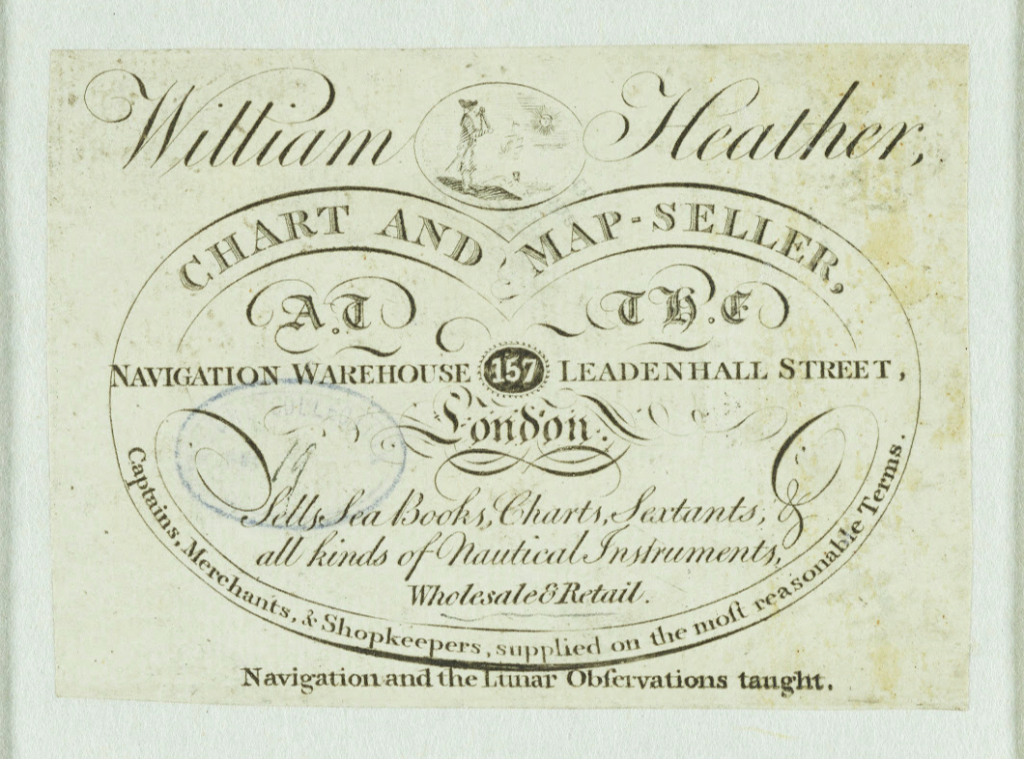
These were not simply specialist publishers, however. Steel & Co were, from the early nineteenth century, principally ‘Chart & Map Sellers’, but according to their trade card also sold ‘Sextants, Quadrants, Telescopes, and all kinds of Nautical Instruments, Wholesale & Retail’. ‘Captains, Merchants, and Shop-Keepers’ would all be ‘supplied on the most reasonable terms’.[35] Heather also sold navigational instruments alongside nautical books and charts, and his partnership with Norie added another element; Norie’s father James had kept a private academy in Wapping, and John provided mathematical instruction from Heather’s premises from the late 1790s onwards (Fisher, 2004). The Navigation Warehouse in Leadenhall Street, just along the road from East India House, became the Navigation Warehouse and Academy. At that point, it was offering all three of what David Miller has called the hardware, software and wetware of navigation; respectively the instruments, the books and charts that enabled the instrumental data to be translated into values for latitude and especially longitude at sea, and the people instructed in how to use them (Miller, 2015). Heather’s navigation warehouse, in particular, had become a kind of one-stop-shop for the Company’s essential navigational needs.
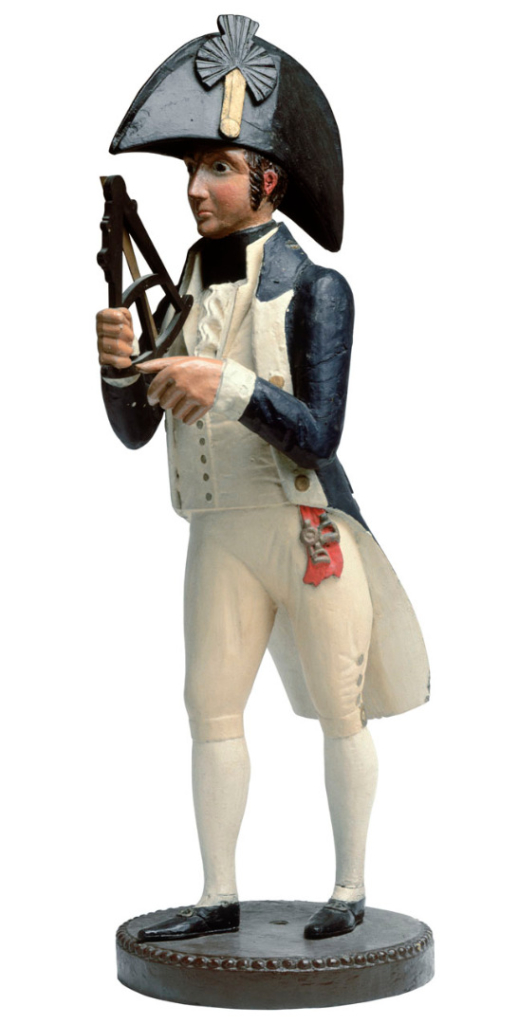
This was in effect an extension of an established tendency for different aspects of navigational business to be combined under one roof. It was not unusual for the publishers of mathematical books to offer mathematical instruction as well, for example. (Indeed, Kevin Tracey has shown that such publishers were often practical mathematicians venturing onto the terrain of stationers rather than the other way around.) There is eighteenth-century evidence of teachers of mathematics and navigation also selling instruments, and of navigational instrument-makers (as identified by their trade cards and shop signs) also selling navigational books (see examples in Lambert, 2001; Bennett, 2014; Beeley, 2019). One case is Henry Gregory, who made and sold instruments at the sign of the Azimuth Compass (also on Leadenhall Street), and who was listed on the title-page of Robert Stevens’s A Complete Guide to the East-India Trade (1766) as one of its retailers – alongside the aforementioned David Steel.
The consolidation was not, however, total. Although the use of marine chronometers as aids to finding longitude became commonplace on board Company ships in the last years of the eighteenth century (Wess, 2015, pp 201−22), these were not sold through navigation warehouses. At least two of the firms likely to have supplied chronometers to the East India Company in the late eighteenth and early nineteenth century had premises in Cornhill, which ran into Leadenhall Street – Paul Phillip Barraud and John and Miles Brockbank. The Brockbank premises were actually in Cowper’s Court, just off Cornhill, which was also home to the Jerusalem coffee-house – the semi-official London resort of East India Company captains and shipowners, and from around 1773 the headquarters of the Society of East India Company Commanders. There is positive evidence of a Barraud chronometer being carried aboard an East India Company ship prior to 1790, and while there is not the same attestation for Brockbank it is highly likely that the firm’s decision to embark upon making marine chronometers had some bearing upon their location, right next door to one of their key markets – the one body of men who might be expected to use chronometers and who could reliably afford them.
In addition to navigation warehouses and chronometer-makers, the late eighteenth century saw five instrument-makers (of various classes, optical as well as mathematical) in business on Leadenhall Street and Cornhill (Clifton, 1995). There were also a variety of specialist stationers, some of whom produced specially printed logs specifically for the use of Company captains. These carried the Company’s arms at the head of each page and provided spaces for the determination of longitude both by lunar observation and by chronometer – thereby enabling us to determine the relative frequency with which those techniques were used. As Simon Davidson has noted, the establishment of competitors to John Arnold in the manufacture of plausibly affordable marine chronometers from the early 1780s resulted in their rapid adoption for determining longitude on Company ships, with a parallel decline in the use of the lunar distance method – both in terms of the frequency with which it was recorded on given voyages and the proportion of voyages where the lunar method was made use of at all (Miller, 2015; Davidson, 2019). The Company nevertheless continued to insist that its officers maintain and certify their competence in this method.
The fact that the Company did not seek to centralise, or to assume financial responsibility for, the assembly of skills and equipment which had been declared necessary to the command of its ships did not prevent the clustering of a large number of businesses connected with the technical aspects of navigation around its headquarters, and the gradual consolidation of some of these into navigation warehouses. The question of why the Company did not seek to do this is less clear – in other aspects of fitting ships out for sea they did deal directly with suppliers, viewed the resulting purchases as Company property, and gave over a considerable amount of space to how these were to be looked after and preserved for inspection on a ship’s return, down to carpenters’ tools.[36] Certainly Company captains (and to a lesser extent officers) could expect to do well enough from their entitlement to trade on their own account up to a certain weight of goods – what was called the private trade allowance – to allow them for the most part to equip themselves handsomely (Sutton, 2010).
It is possible that the pattern of recruitment of new officers was too erratic to encourage the Company to buy material of this kind in bulk; demand was unpredictable, in other words. And it may have been that tacitly requiring officers to provide their own navigational instruments was felt to imply a personal responsibility to know how to use them. It was consistent with the Company’s wider tendency to treat the knowledge-making activities of its servants as a form of free enterprise – the first attempt to systematically exploit the navigational knowledge held at East India House, for example, by Alexander Dalrymple, resulted in his appointment as hydrographer to the Company in 1779, and the payment of an annual salary to a scientific servant for the first time – but it was Dalrymple’s initiative (Cook, 1992, pp 70−158). And it was common practice in other large maritime organisations, notably the Royal Navy, for officers to equip themselves.
With all this in mind, then, the emergence of new forms of business, skilled instrument makers, and chart sellers around East India House, despite the fact that the needs they partly hoped to service were generated by Company stipulations, may have been only an indirect consequence of the Company’s London location. Because they sold directly to captains and officers and not to the Company itself, the establishment of the Society of East India Commanders, and its headquarters at the Jerusalem coffee-house, seems more immediately consequential. This was a mutual society and pension fund, formed on the Company captains’ own initiative, intended to strengthen their hand in negotiations with their employers and to relieve members and their families in distress. This association made the coffee-house a quasi-public centre for news of the Company (quasi-public because by subscription – another form of enterprise the Company indirectly gave rise to). It became famous as the place where, for a price, the most accurate and up-to-date information about East India shipping could be obtained. And it drew in many allied trades: merchants, insurance brokers and shipbuilders all gave the Jerusalem as an address in London directories. The fact that the actual clients for the businesses whose emergence we have described, the officers and shipowners of the Company’s maritime service, congregated at the junction of Cornhill and Leadenhall Street probably mattered more immediately to those looking to supply navigational instruments, books, charts and skills than the presence of the Company’s headquarters nearby.
By the end of the eighteenth century the Company was beginning to refashion itself and its headquarters as a knowledge-making space. It was beginning to sponsor the publications of Dalrymple, the botanists William Roxburgh and Patrick Russell, and others who had worked under its auspices in India. A training college designed to programmatically equip its servants with the knowledge and skills they needed to conduct its trade and, in effect, to govern large parts of India, opened at Haileybury in 1806. But the recognition that the forms of knowledge needed to successfully govern India, exploit its territories, and bolster the Company’s flagging reputation as an instrument of public good was never quite applied in the same way to its maritime service, despite Dalrymple’s pioneering status as a scientific servant of the Company. Instead, East India Company officers and commanders established their own competence and had it certified to the Company when a new navigational technique was stipulated. They equipped themselves for the difficult business of finding longitude at sea. And the knowledge they acquired or bought in the form of charts and pilot-books had largely been digested from the experience of former Company captains.
Though the knowledge and experience in the Company’s archive remained nominally accessible to its captains, in practice the production and refinement of navigational knowledge and equipment for the East India voyage seems to have been digested from the knowledge of the community of East India officers themselves by entrepreneurs, and then sold back to the Company’s officers for use at sea – by the early eighteenth-century chartmaker John Thornton, for example, who consulted with EIC commanders about his charts (Cook, 2001). This practice was traceable back to the 1620s and the publication of sailing directions to India as part of Samuel Purchas’s Purchas his Pilgrimes (1626), through the English Pilot of the early eighteenth century, and the charts, plans and sailing instructions coming out of Dalrymple’s hydrographic office (Cook, 1992). East India House became a centre of gravity for skilled chartmakers and instrument makers rather than a centre of calculation in itself.
Conclusion
https://dx.doi.org/10.15180/211506/005The significance of institutional spaces in consolidating, representing and safeguarding productive knowledge varied, as we have seen, according to the requirements of the corporations they housed. These changed over time, as did the expectations of those they interacted with. The highly sensitive matter of the creation of currency at the Mint led to concerns about encroachment of outsiders on particular spaces and the removal of tools and equipment from them. However, careful performances, to the right audiences, of the skilled work of materials testing could demonstrate mastery and control. At Trinity House, the expertise of the Elder Brethren, which secured their chartered rights, was supported by their displayed history and stored archive, as well as asserted through their practices of examination and certification. Both there and at East India House, navigational competence was largely considered a matter of practical experience gained at sea, supported by teachers, texts and instruments available elsewhere in the city and its environs. Trinity House, however, needed to assert their authority to act on and certify this competence, while the EIC was content to contract it out. Knowledge of the EIC itself, and its wants and practices, including the extraction and supply of the commodities it shipped as well as the actual business of shipping (Frey, 2009, pp 551−52), became a vital part of various knowledgeable or knowledge-making industries.
By focusing on institutional sites, these case studies have brought to light a range of people, things and activities that were crucial to the use and production of knowledge in the urban context. They demonstrate that we cannot think about individual corporations without being aware of their varied make up and their embedded contexts. The early modern Mint relied on semi-autonomous groups of moneyers and assayers as well as its crown-appointed officials. Its rules and processes were also dictated by their location, cheek-by-jowl with ordnance artificers and spectacle-seeking visitors. The location of Trinity House was chosen to suit the needs of its members and convenience of its business, from the employment of ballastmen to the collecting of dues and serving of royal and merchant navies. That neighbourhood was, in turn, shaped by the presence of a series of institutional sites, including the East India Company and the nearby Society of East India Commanders, drawing in sellers and makers of maritime texts, knowledge and instruments. Such entrepreneurs also looked to Trinity House and the East India House to endorse their inventions and products, whether with financial support or some mutually beneficial advertising.
We suggest that ‘metropolitan science’ can be understood as a product of people working in and around such corporate, commercial and craft- or practice-oriented sites. Not only the product of elite officials or external experts, it was also constructed by artisans, practitioners, contractors, clerks, visitors, examiners and doormen.
Acknowledgements
We thank the Leverhulme Trust for funding the Metropolitan Science project, and the project’s advisors, particularly Jim Bennett and Simon Werrett, for their support.

